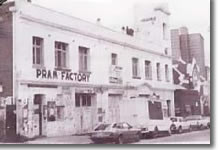
LA MAMA
- AUSTRALIAN PERFORMING GROUP - PRAM FACTORY
The AUSTRALIAN PERFORMING GROUP,
drawing its members often from Melbourne universities, began as the amateur,
cooperative LA MAMA COMPANY in 1968. It was reformed as a professional group,
numbering about fifty, in 1970 and disbanded in 1981. The group had from its
inception a strong commitment to Australian plays and to innovation, with an
emphasis on raw theatre, with little or no props, make up or other theatrical
trappings.
Its first venue was at LA MAMA,
an intimate performance space in a shabby, two storey former shirt factory in
Faraday Street, Carlton, where the company operated from 1968-1970. This theatre,
opened by Betty Burstall in July 1967, was modelled on a namesake in New York.
It was an accessible performance space open to a wide range of performers and
concepts, but its main occupants were the La Mama Company (who later changed
their name to the AUSTRALIAN PERFORMING GROUP) and TRIBE, an improvisational
group.
The early years of the theatre were
distinguished by creative vitality and energy in performance. The companies
presented around twenty five Australian plays, including `Dimboola', `The Removalists'
and `Norm and Ahmed', as well as seven events and eight plays from overseas
in the first two years.
In a quest for more space, in 1970
the Australian Performing Group then moved to the PRAM FACTORY Pram  Factory
opening with a production of `Marvellous Melbourne' created by playwrights Jack
Hibbard and John Romeril. This site was around the corner from La Mama, in Drummond
Street, Carlton. The building had been both a livery stable and a factory to
make Paramount prams. The main performance space was in the upstairs Front Theatre,
which seated around one hundred and fifty people. In 1973, the APG also established
the smaller Back Theatre, with a capacity of seventy five, for specialised work.
By 1978, however, the company's energy was dissipating and the group was fragmenting.
The sale of the Pram Factory for development in 1980 then finished the company.
Despite efforts to preserve the venue, the site became a supermarket.
Factory
opening with a production of `Marvellous Melbourne' created by playwrights Jack
Hibbard and John Romeril. This site was around the corner from La Mama, in Drummond
Street, Carlton. The building had been both a livery stable and a factory to
make Paramount prams. The main performance space was in the upstairs Front Theatre,
which seated around one hundred and fifty people. In 1973, the APG also established
the smaller Back Theatre, with a capacity of seventy five, for specialised work.
By 1978, however, the company's energy was dissipating and the group was fragmenting.
The sale of the Pram Factory for development in 1980 then finished the company.
Despite efforts to preserve the venue, the site became a supermarket.
Source:
Philip Parsons
(general ed.) with Victoria Chance, Companion to Theatre in Australia
(Sydney, Currency Press in association with Cambridge University Press, 1995).
Leslie
Rees, Australian Drama 1970-1078, rev. and enlarged edn (North Ryde,
Angus and Robertson, 1987).
See also entries:
La Mama
The Pram Factory

 Factory
opening with a production of `Marvellous Melbourne' created by playwrights Jack
Hibbard and John Romeril. This site was around the corner from La Mama, in Drummond
Street, Carlton. The building had been both a livery stable and a factory to
make Paramount prams. The main performance space was in the upstairs Front Theatre,
which seated around one hundred and fifty people. In 1973, the APG also established
the smaller Back Theatre, with a capacity of seventy five, for specialised work.
By 1978, however, the company's energy was dissipating and the group was fragmenting.
The sale of the Pram Factory for development in 1980 then finished the company.
Despite efforts to preserve the venue, the site became a supermarket.
Factory
opening with a production of `Marvellous Melbourne' created by playwrights Jack
Hibbard and John Romeril. This site was around the corner from La Mama, in Drummond
Street, Carlton. The building had been both a livery stable and a factory to
make Paramount prams. The main performance space was in the upstairs Front Theatre,
which seated around one hundred and fifty people. In 1973, the APG also established
the smaller Back Theatre, with a capacity of seventy five, for specialised work.
By 1978, however, the company's energy was dissipating and the group was fragmenting.
The sale of the Pram Factory for development in 1980 then finished the company.
Despite efforts to preserve the venue, the site became a supermarket. 